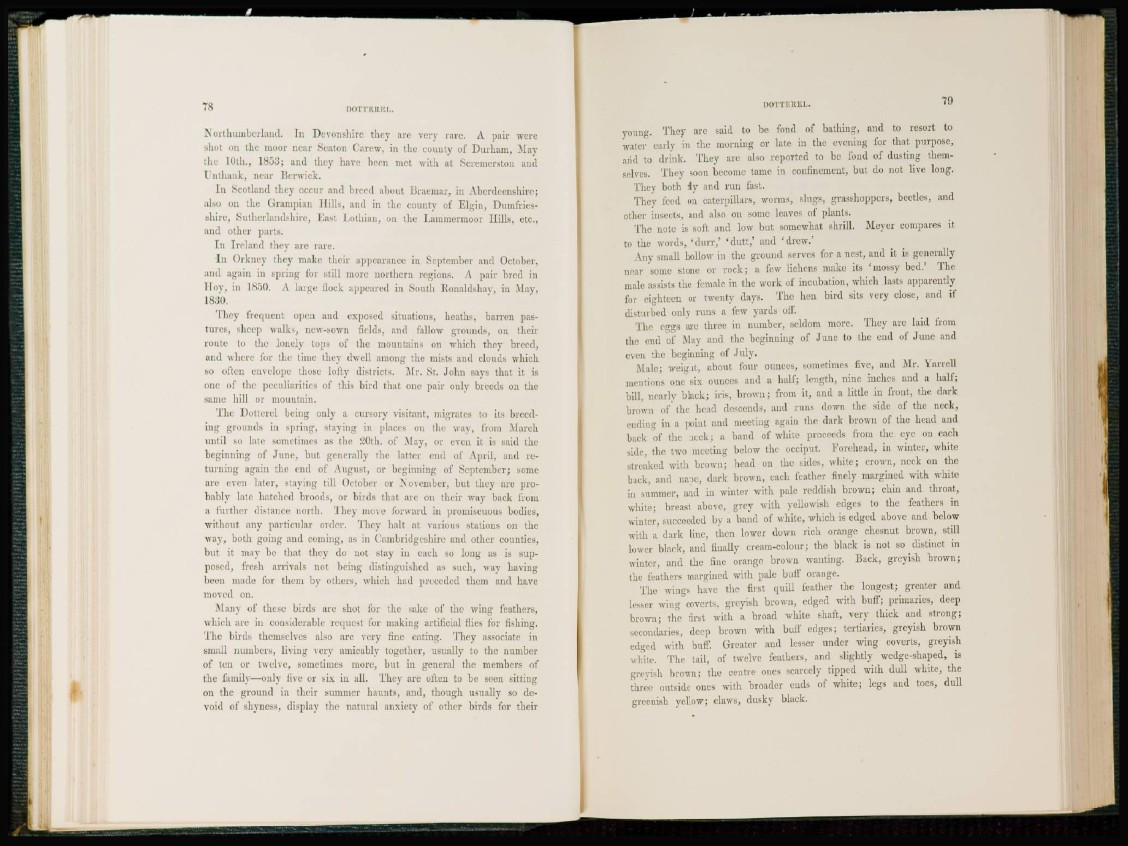
78 DOTTEREL.
Northumberland. In Devonshire they are very rare. A pair were
shot on the moor near Seaton Carew, in the county of Durham, May
the 10th., 1853; and they have been met with at Scremerston and
Unthankj near Berwick.
In Scotland they occur and breed about Bracmar, in Aberdeenshire;
also on the Grampian Hills, and in the county of Elgin, Dumfriesshire,
Sutherlandshire, EaBt Lothian, on the Lammermoor Hills, etc.,
and other parts.
In Ireland they arc rare.
I n Orkney they make their appearance in September and October,
and again in spring for still more northern regions. A pair bred in
Hoy, in 1850. A large flock appeared in South Konaldshav, in May,
1830.
They frequent open and exposed situations, heaths, barren pastures,
sheep walks, new-sown fields, and fallow grounds, on their
route tn the lonely tops of the mountains on -which they breed,
and where for the time they dwell among the mists and clouds which
so often envelope those lofty districts. Mr. St. John says that it is
one of the peculiarities of this bird that one pair only breeds on the
same hill or mountain.
The Dotterel being only a cursory visitant, migrates to its breeding
grounds in spring, slaying in [daces on the way, from March
until so late sometimes as the 20th. of May. or even it is said the
beginning of June, but generally the latter end of April, and returning
again the end of August, or beginning of September; some
arc even later, slaying till October or ^November, but they arc probably
late hatched broods, or birds that are on their way back from
a further distance north. I hey move forward in promiscuous bodies,
without any particular order. They halt at various stations on the
way. both going and coming, as in Cambridgeshire and other counties,
but it may be that they do not stay in each so long as is supposed,
fresh arrivals not being distinguished as such, way having
been made for them by others, which had preceded them and have
moved on.
Many of these birds are shot for the sake of the wing feathers,
which arc in considerable request for making artificial flics for fishing.
The birds themselves also are very fine eating. They associate in
small numbers, living very amicably together, usually to the number
of ten or twelve, sometimes more, but in general the members of
the family—only five or six in all. They are often to be seen sitting
on the ground in their summer haunts, and, though usually so devoid
of shyness, display the natural anxiety of other birds for their
DOTTEREL. 79
young. They are said to be fond of bathing, and to resort to
water early in the morning or late in the evening for that purpose,
arid to drink. They arc also reported to be fond of dusting themselves.
They soon become tame in confinement, but do not live long.
They both fly and run fast.
They feed on caterpillars, worms, slugs, grasshoppers, beetles, and
other insects, and also on sonic leaves of plants.
The note is soft and low but somewhat shrill. Meyer compares it
to the words, ' d o r r , ' ' d u t t , ' and 'drew.'
Any small hollow in the ground serves for a nest, and it is generally
near some stone or rock; a few lichens make its 'mossy bed,' The
male assists the female in the work of incubation, which lasts apparently
for eighteen or twenty days. The hen bird sits very close, and if
disturbed only runs a few yards off.
The eggs are three in number, seldom more. They arc laid from
the end of May and the beginning of June to the end of June and
even the beginning of July.
Male; weight, about four ounces, sometimes five, and Mr. Yarrell
mentions one six ounces and a half; length, nine inches and a half;
bill, nearly black; iris, brown; from it, and a little in front, the dark
brown of the head descends, and runs down the side of the neck,
coding in a point and meeting again the dark brown of the head and
back of the neck; a band of white proceeds from the eye on each
side, the two meeting below the occiput. Forehead, in winter, white
streaked with browu; head on the sides, white; crown, neck on the
back, and nape, dark brown, each feather finely margined with white
in summer, and in winter with pale reddish brown; chin and throat,
white; breast, above, grey with yellowish edges to the feathers in
winter, succeeded by a band of white, which is edged above and below
with a dark line, then lower down rich orange chesnut brown, still
lower black, and finally cream-colour; the black is not so distinct in
winter, and the fine orange brown wanting. Back, greyish brown;
the feathers margined with pale buff orange.
The wings have the first quill feather the longest; greater and
lesser wing coverts, greyish brown, edged with buff; primaries, deep
brown; the first with a broad white shaft, very thick and strong;
secondaries, deep brown with buff edges; tertiaries, greyish brown
edged with buff. Greater and lesser under wing coverts, greyish
w line. The tail, of twelve feathers, and slightly wedge-shaped, is
greyish brown; the centre ones scarcely tipped with dull white, the
three outside ones with broader ends of white; legs and toes, dull
greenish yellow; claws, dusky black.